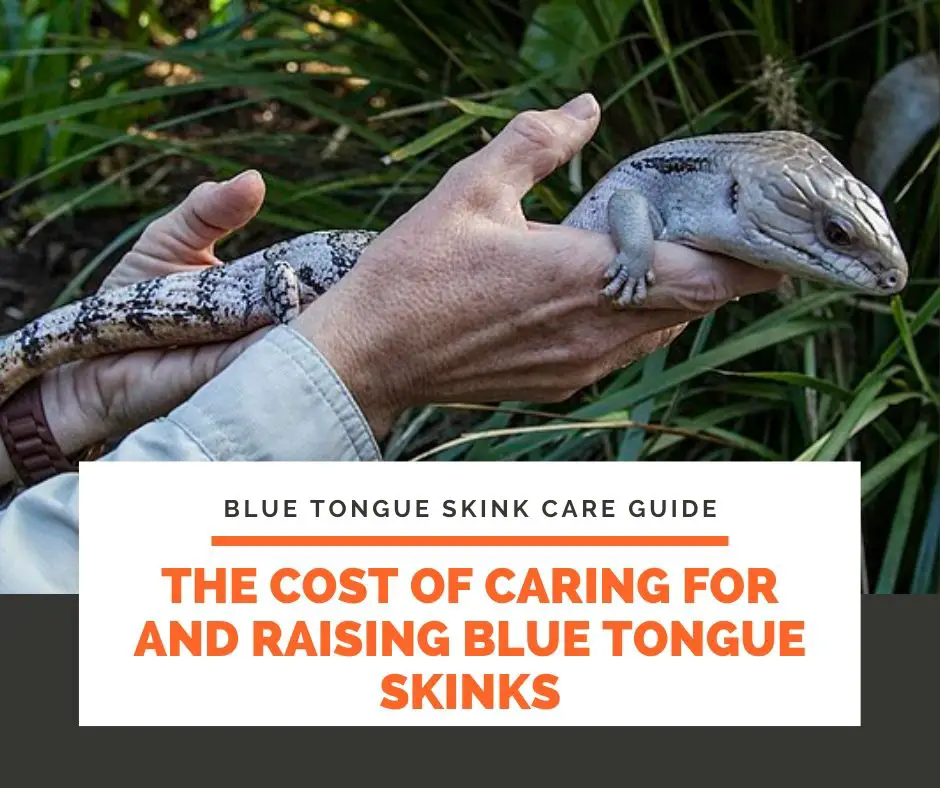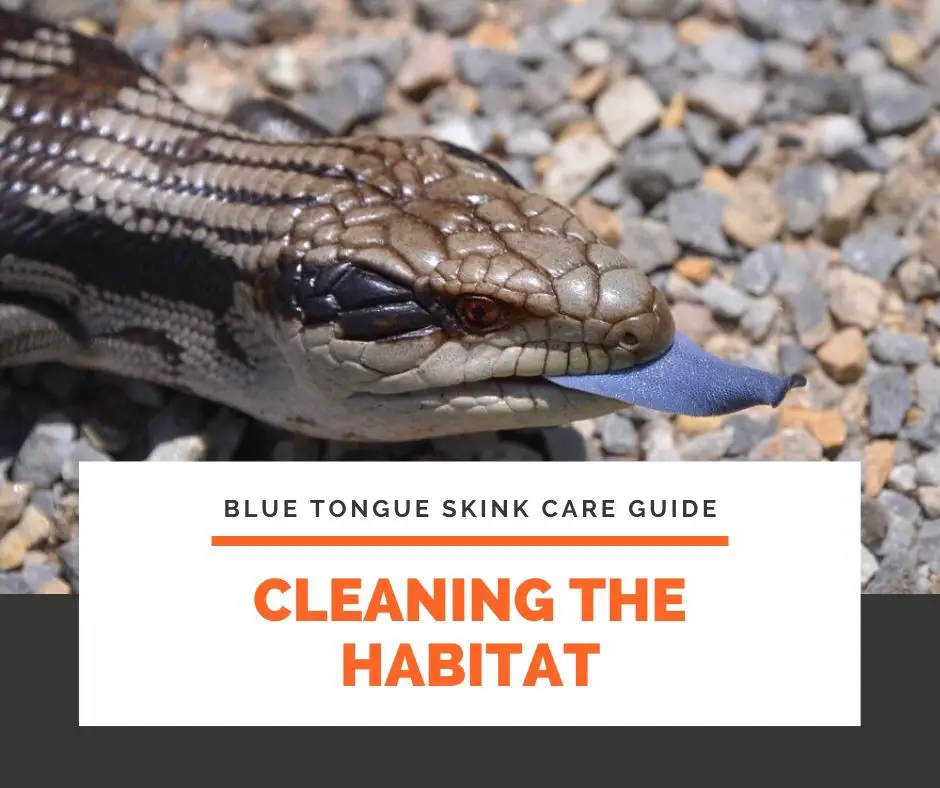Caring for blue tongue skinks is fun. However, it’s not a walk in the park. Anyone with a blue tongue skink will tell you; it is never as simple as caring for cats or dogs.
Blue tongue skinks require proper and intensive care for them to thrive in captivity. For instance, where the ambient temperature for dogs and cats is never a significant concern for you, blue tongue skinks require specific temperatures.
Handling and bonding with your blue tongue skink are never as natural as for the dogs and cats. For these and more reasons, we came up with this ultimate guide for caring for blue tongue skinks.
It will be a long read, but I guarantee it’s worth every minute. By the time you finish reading this article, you will be feeling like a blue tongue skink pro.
Contents
- What Are Blue Tongue Skinks?
- Why Do Blue Tongue Skinks Make Good Pets?
- Fun Facts About Blue Tongue Skinks
- The Cost of Caring For and Raising Blue Tongue Skinks
- Where Can I Buy a Blue Tongue Skink?
- What Kind of Home Does My Blue Tongue Skink Need?
- How Do I Choose The Right Blue Tongue Skink For Me?
- Blue Tongue Skink Diet: What Should I Feed Them?
- How Do I Care For My Blue Tongue Skink?
- Cleaning the Habitat
- Physical Behavior Health Symptoms
- Conclusion
What Are Blue Tongue Skinks?

Appearance and Origin
Blue tongue skinks are one of the largest lizards in their family. They have a long and tabular body, with short stumpy legs.
Their head is broad and triangular, and their long blue tongue characterizes their name.
In Australia, they are commonly known as blue tongue skinks, blue tongues, or blueys. They comprise the Australian genus (Tiliqua), Tiliqua gigas from New Guinea, and Indonesia, and Tiliqua Nigrolutea in Tasmania.
Even though there are plenty of blue tongue species, only 11 subspecies are commercially available.
In the US, exportation laws regarding blue tongue skinks are stringent. Thus, it is not easy to acquire Australian Blue tongue skinks.
The scientific name of blue tongue skinks is Tiliqua, and they belong to the skink family (Scincidae), and Egerniinae subfamily. They belong to the Reptilia class and the Animalia Kingdom.
They are commonly bred in captivity, and also sold as household pets. They are friendly and much easier to raise compared to bearded dragons.
Depending on the type of blue tongue skinks, they live in various climates, the most common being Northern and Eastern Australia.
Their natural habitats are grassland, woodland, and they also adapt well to urban, suburban gardens and parks.
Blue tongue skinks, just like other reptiles, are cold-blooded animals. Thus, they depend on the external temperature to regulate their body.
They are, therefore, diurnal animals that are active during the day and asleep during the night.
In the wild, they spend most of their day basking in the sun. However, when the sun is scorching, they like to burrow underground to avoid overheating.
At night, they also sleep underground to feel the earth’s warmth and escape from nocturnal predators.
Blue tongue skinks are omnivorous animals. Thus, they feed on insects, meat, vegetables, and fruits.
Gender Differences and Mating
Blue tongue skinks are antisocial animals. Thus, you should not house them together. Also, it is inadvisable to house a male and a female together unless you are breeding them.
They are slow animals who puff and show off their blue tongue to scare away predators.
Blue tongue skinks become sexually mature at the age of 18 -24 months. Mating process for blue tongue skinks is aggressive and sometimes leaves the female with injuries.
Blue tongue skinks give birth to live babies, unlike other reptiles who lay eggs. The gestation period of blue tongue skinks is 3-5 months.
When the baby blue tongue skinks are born, they are usually small but very independent. They don’t need their parents to give them food. Their first nourishment is the placenta.
The average size of blue tongue skinks is 24 inches long. However, some species like pygmy blue tongue skink only grow to a total length of 9 inches.
Depending on the type of blue tongue skink, they come in various colors, sizes, patterns, and skin transparencies.
Why Do Blue Tongue Skinks Make Good Pets?

Blue tongue skinks are hardy pets that thrive well in captivity.
Compared to other reptiles, blue tongue skinks make better pets as they are docile and easy to care for, even for people with kids.
If you provide them with the right temperature, lighting, diet, water, and enough space for them to move around, they are less likely to present complications, and they live long in captivity.
Other reasons why blue tongue skinks make good pets is:
- Cute and fun to look at.
- They are diurnal animals just like humans, and thus, it’s easy to interact with them.
- They are friendly, docile, non-venomous, and easy to handle. Therefore, blue tongue skinks are safe to handle.
- They feed on almost everything readily available in any ordinary household, and they are not so picky.
- They are small and, it only needs you approximately 55-gallon tanks to house them. Thus, most houses and apartments can accommodate them.
- They have a long lifespan. In captivity, blue tongue skinks can live for up to 25 years. But their average lifespan in captivity is 15-20 years.
- Except for the startup cost, they are inexpensive to maintain, and if you care and provide them with the proper diet, they only have a few or no health issues at all.
- It’s easy to tame blue tongue skinks primarily if they are captive-bred.
Fun Facts About Blue Tongue Skinks

- When blue tongues feel threatened, they puff up their body, stick out their long blue tongue and hiss. And, if the predator doesn’t get off, they flatten out their body to look larger.
- Even though they do not have developed teeth, they have a powerful bite. Also, they do not let go quickly and, thus, the pain is excessive.
- They have overlapping scales that help them to keep off dirt and sand.
- If they are in good health, they shed every six weeks for the adults. Shedding can significantly reduce regular food metabolism.
- Blue tongue skinks are diurnal animals that spend most of their day searching for food and basking in the sun.
- Blue tongue skinks can be used to control insects as they majorly consume insects, slugs, and snails.
- Blue tongue skinks can detach their tail from the body to flee from the predator.
- It’s easy to acquire a blue tongue skink. Blue tongue skinks are readily available all around the wild. You can purchase one from museums, zoos, or at the pet stores.
- Unlike most reptiles, blue tongue skinks are viviparous animals that give birth to live babies.
- Blue tongue skinks can have monogamous breeding. Thus, one pair can return to each other year after year.
- Blue tongue skinks are endangered species being vulnerable to cats, dogs, snakes, foxes, and birds of prey. Juvenile skinks in the wild barely survive past their first year.
- Blue tongue skinks sneeze a lot. When they are burrowing, dirt penetrates through their nose, and sneezing helps them clear off the dirt. However, if they sneeze and excrete discharge, they might be having an infection.
The Cost of Caring For and Raising Blue Tongue Skinks

Blue tongue skink startup costs can be overwhelming. However, they are cheap to maintain if you keep them healthy.
The cost of maintaining a blue tongue skink will depend on the diet you plan to provide them. But the good news is that blue tongue skinks are omnivorous animals that feed on everything you feed.
To get a real picture of how much you are likely to spend on a blue tongue skink, keep reading!
Cage Setup
Setting up a blue tongue skink cage will depend entirely on how much you are willing to spend. You can either go for sophisticated or just a simple enclosure.
The simplest cage can cost as low as $150, while the sophisticated one can cost $500 and above.
Let’s see the basic requirements cost breakdown.
First, the best permanent terrarium for blue tongue skinks is either glass or plexiglass terrarium. Finding a good one, either new or old, is easy.
The cost of each will depend on the tanks’ size. If you start with a baby blue tongue skink, you can start with a 20-30 gallon tank. It will cost you approximately $25-$50 for a new one.
However, starting with a small tank will cost you later because you will have to replace it. Blue tongue skinks grow fast; it is better if you would start with a 40-gallon tank.
If you want to start with an adult blue tongue skink, you should begin with a 40gallon tank. But the best size for an adult blue tongue skink is 55gallon tank. It will cost you approximately $100-$500 depending on the materials used.
Once you have the tank, the next necessary and crucial items will be the substrate, thermometer, hygrometer, heating pad, basking rocks, branches, plants, water and food bowl, and dietary supplements.
Here is a breakdown of all those environmental enrichments for blue tongue skinks.
| Item | Cost in $ |
| Substrate | 10-14 |
| Heat pad | 8-23 |
| Thermostat | 15-40 but some can go up to 250 |
| Light and heating | 10-30 |
| Tank accessories (plant, rocks, water bowl, food bowl, and décor) | 70-100 |
Depending on this budget, it will cost you between $176 – 216 on environmental enrichments. It is worth noting that it is critical to include all those in your blue tongue skinks.
Lack of one of the mentioned accessories can cause stress to your blue tongue skink.
However, UVB and UVA lighting is the most significant equipment for blue tongue skinks. Lack of UVB can cause metabolic diseases for blue tongue skinks.
Also, the lack of UVA will affect your blue tongue skink activities.
Blue tongue skinks are diurnal animals that need to be active during the day and sleep at night. If you don’t include UVA during the day and put it off at night, it will affect your blue tongue skink activities.
Diet
Blue tongue skink diet comprises insects, meat, vegetables, and fruits. Luckily, they can consume almost all vegetables, fruits, and meat in your house.
Thus, you will only need to buy insects and supplements for your blue tongue skinks. It will cost you approximately $5 to purchase live insects for blue tongue skink a week.
Calcium and vitamin supplements will cost you approximately $15.
Cohabitation
Blue tongue skinks are antisocial creatures. Thus, it’s not advisable to house two of them together.
Blue tongue skinks are expensive. The cost of one depends on the kind of morph you want. Some of the most available morphs are Northern blue tongue skinks.
The cost for a Northern blue tongue skink will cost approximately $150 for babies and $250 for adults.
However, rare morphs like shingle backs and contrarians blue tongue skinks will cost you approximately $1500 and $5000 each.
For beginner blue tongue skink keepers, it’s inadvisable to start with the rare, expensive morphs.
Medical cost
Vet checkup costs and medical bills will depend on the health issues that your blue tongue skink is experiencing. It can cost you $20-$100s per therapeutic session.
However, if you feed and provide your blue tongue skink with proper diet and clean habitat, you are less likely to experience those medical charges.
Poor diet, mites, inadequate heating, and lighting, and use of the wrong substrate, are the common causes of infections in blue tongue skinks.
Therefore, if you ensure that your blue tongue skink habitat and diet necessity is per the required, health issues will never be your worry.
You can also buy health insurance for your blue tongue skink and pay monthly installments as little as $9.
Where Can I Buy a Blue Tongue Skink?

Rule #1
Don’t ever buy a blue tongue skink from an unknown breeder. Do your homework first.
Before purchasing a blue tongue skink, you should be able to answer these questions about the breeder.
- Do they have a good reputation?
- What do their customers say about them?
- Do they know about blue tongue skinks?
- Are they raising blue tongue skinks themselves?
Pet Stores
Most beginners will tell you pet shops are the best places to buy your blue tongue skink. It is because pet stores contain almost everything that you will need to get started.
Also, the pet shops have a variety of morphs and several breeds to choose from. Their prices also tend to be lower. Also, you can choose either a baby, juvenile, or adult, depending on your liking.
The worst thing about pet shops is that they can provide you with inadequate or misleading information about blue tongue skink care. Thus, it is critical to do your research.
Another con about pet stores is that sometimes their blue tongue skinks are not as healthy as those from breeders. It might be because, unlike breeders, who do it for passion, their idea is purely based on business rather than love.
Also, the blue tongue skinks for pet stores are shipped and displayed with other pets. And thus, might collect pests and other infections.
Therefore, buying your blue tongue skink from a pet store is risky and doesn’t recommend you.
Breeders
Fortunately, with the latest advanced technology, it is easy to find a local blue tongue skink from your area.
Thus, depending on what you want, you can easily filter your search to your specific liking.
Some will specialize in rare blue tongue skinks like shingle back and Centralian. But fortunately, you can get your specific breed from small breeders at a low price or pet store price range.
If you are just a beginner, getting your blue tongue skink from a breeder would be the best choice. It is because breeders are passionate about blue tongue skinks, and they, therefore, share their enthusiasm about breeding them.
You can also meet blue tongue skink breeders from your local town if there’s a reptile show in your area.
Classified ads/Facebook Groups
It is most likely that if you have been searching for blue tongue skinks in Facebook groups or pages for you to come across amazing blue tongue skinks ads.
The worst mistake that most beginners commit is the failure to do proper research before starting. Therefore, they encounter endless problems, and most of them give up on the way.
The seller will tell you it’s easy to take care of a blue tongue skink. If you don’t commit to the task, you might end up frustrating and causing death to your blue tongue skinks.
You should also be ready to replace light and thermometers every year or so.
Reptile Rescue
It’s possible to get your blue tongue skink from a reptile rescue center. However, most come from abusive or neglectful situations. Thus, it might take you long before you can tame and handle them.
Fortunately, in those centers, they have experts who can tame and ensure that the animals are safe for the public before selling them.
Also, they involve vet doctors who make sure that the animals are in good health. And the best part is, if you get your blue tongue skink from a rescue center, you only contribute a small fee.
But, you will have to prove that you can provide excellent habitat for the animal. And, you are not planning to resell for profits.
And if things don’t work out well for the blue tongue skink, they do not hesitate to take them away from you again.
What Kind of Home Does My Blue Tongue Skink Need?

Tank/Vivarium
You should set up your blue tongue skink habitat even before you bring it home. And, ensure that you provide adequate heat in its environment as soon as it arrives.
There is a variety of blue tongue skink habitat available. However, a glass aquarium with a mesh lid is the most reliable and inexpensive of all. Also, it allows you to have the best view of your new blue tongue skink.
Even though it might be more massive than most others, its transparency makes it perfect for your blue tongue skink as it offers a sense of space.
Just like there are no opaque walls in their natural habitat, you should also make it in captivity.
When choosing a terrarium for your blue tongue skink, you should always remember that adequate space makes them comfortable.
If you go to a small tank, you should know that you will soon have to replace it. A small tank can intensively stress out your blue tongue skink. However, no container is too big for a blue tongue skink.
If you start with a baby blue tongue skink, 40 gallons should be the smallest tank you can ever choose.
Luckily, if you start with a 40-gallon tank, you will only need to upgrade to a bigger one when your skink reaches 2years.
Even though you can house an adult blue tongue skink in a 40-gallon tank, it’s worth noting that it limits your blue tongue skink freedom and causes stress.
Some will go for a terrarium that has a top opening. However, it’s not the best choice as it will stress you when you want to clean and handle your blue tongue skink.
Also, the terrarium with a sturdy mesh is best as it can hold a light dome, and the mesh is useful for preventing moisture buildup in the tank.
Click here for the top-rated blue tongue skink cages.
Substrate
The substrate is the blue tongue skink bedding or flooring. At the pet shop, they will probably advocate sand, wood chips, or pebbles.
However, you must know those blue tongue skinks are burrowing animals that are highly likely to ingest small particle substrate.
Once they ingest, they develop impaction issues that lead to difficulty moving bowels for your blue tongue skink.
Therefore, it is necessary to do thorough research on the substrate before deciding on the one to use for blue tongue skink.
Although most people think reptile carpet is the best substrate for blue tongue skinks, it has its own disadvantages.
For instance, blue tongue skinks being burrowing animals, they might find themselves under the carpet trying to burrow in.
Therefore, the best substrate for blue tongue skink would be filtered hypoallergenic aspen wood substrate.
Apart from providing the natural habitat for blue tongue skinks, those substrates contain large pieces of wood.
Therefore, the substrate cannot be easily ingested by your blue tongue skink. And, the substrate can easily absorb the blue tongue skink waste and smell.
Light and Heat
In the wild, blue tongue skinks spend most of their day basking. Thus, light and heat is a basic need for blue tongue skinks in captivity.
UVA generates heat that your blue tongue skink requires to keep it warm. Also, it sets the day/night cycle for blue tongue skinks.
Blue tongue skink digestion can not take place if there’s no adequate heat. Also, the blue tongue skink activeness can be affected by lack of heat, and that explains blue tongue skink brumation during winter.
UVB is also some form of radiated energy and is vital for blue tongue skinks as it provides vitamin D3, which helps them absorb calcium from their diet.
If UVB is insufficient for blue tongue skinks, they can suffer from metabolic diseases, lethargy, and growth problems.
For better growth and health for blue tongue skinks, you must provide at least 12-14 hours of UVA and UVB daily.
To make the light adequate for your blue tongue skinks, you should ensure that you install separate lamps for UVA and UVB.
The best UVB lighting should cover at least half of the tank’s total length. And, it should not be blurred by any glass.
You should also ensure that the distance between basking lamp and the basking area for your blue tongue skink is no more than 12” and no less than 10”.
It is worth noting that some bulbs are too strong and can burn your blue tongue skink. Thus, you should only go for the reptile most recommended lamps like Evergreen UVB bulb.
For UVA lighting, you don’t have to go overboard and buy the most expensive bulb. The ordinary lamp that you mostly use at home is enough.
However, you should replace both UVA and UVB bulbs each year.
Even though blue tongue skinks like their environment are hot, they sometimes need to cool off their bodies from excessive heat. Thus, you should ensure that their tank has one side more heated than the other.
The hotter side or the basking side should have a temperature ranging from 95-1100F. The cooler side can go as low as 850F, but if at night the tank temperature goes below 650F, you should add a ceramic heat emitter.
To ensure that the temperature in your blue tongue skink is adequate, you should ensure that it includes both thermometer and hygrometer.
If you want the best results instantly, you should ensure that you invest in a good, digital thermometer.
Basking Accessories like Branches, Rocks, and Hidey Holes
Blue tongue skinks will be spending most of its day basking. Thus, you should ensure that you provide a basking rock or log.
Outsourcing branches from outside can be fatal as they could contain pests, parasites, or chemicals that can affect blue tongue skinks.
Artificial rocks are tremendous but never electricity heated ones. It is because blue tongue skinks can get burned by those electric rocks.
In the wild, blue tongue skinks tend to burrow underground when the temperature is excessively hot, and at night to get the underground warmth.
Therefore, you should also include hiding areas for your blue tongue skink. The hiding areas should be large enough for your blue tongue skink to enter and leave freely.
The plants are necessary to provide your blue tongue skink with hiding areas and to make the tank look as natural as their wild habitat.
Dishes and Bowls
Blue tongue skinks require both food and water bowls. The food bowl should have a higher edge to prevent live insects from escaping. The other side should be low enough for your blue tongue skink to access.
The water bowl should be large enough for your blue tongue skink to soak in. However, blue tongue skinks are poor swimmers, and thus it should not be too deep as they can drown.
How Do I Choose The Right Blue Tongue Skink For Me?

There are varieties of blue tongue skinks species. However, not all species make good pets. Even so, the kind of species you pick depends on what makes you happy.
A pet is an animal you like and would like to bond with. Thus, choosing a blue tongue skink for you, you should consider:
- Which species catches your eyes?
- Which one appears prettier for you?
- Which one is less aggressive?
- What comes through your mind when you look at each one?
Once you spot the one that attracts you more, you can request the pet store attendant to let you handle it. That way, you will see if he’s overly aggressive or welcoming and calling for attention.
It’s wise to choose the one that relaxes in your arms and lets you feed it. Some blue tongue skinks can remain aggressive throughout their lives even after taming them.
Blue Tongue Skink Health Checklist
- Must be alert and responsive
- Are the eyes sunken or cloudy?
- If it has any discharge through the eyes, nose?
- If it’s dull or loose?
- If its skin is entirely shed?
- If there’s any scars or missing limbs?
If any of the blue tongue skinks present any of the above checklists, you should not pick it as it could be sick.
But, if they all don’t have any of the symptoms, then you are ready to choose the one that is most appealing to your eyes.
But if none seems to bond with you, then you can either pick either or seek another breeder.
Remember that a blue tongue skink can live up 25 years. Thus, you should choose one that makes you happy from the beginning as you will be spending time with it for a long time.
It’s difficult to tell the gender of a young blue tongue skink. Thus, if you choose a baby or juvenile blue tongue skink, you might never know its gender until it’s older.
But, unless you are planning to breed your blue tongue skink, gender is never an issue.
Now that you have found the best blue tongue skink that catches your eyes, it is now time to take it home. Remember that setting up the cage should come first before bringing your pet home.
Blue Tongue Skink Diet: What Should I Feed Them?

Protein
Blue tongue skinks are omnivorous animals that feed on both plants and animals in the wild. Their diet consists of; insects, slugs, snails, larvae, and other invertebrates in the wild.
How much protein to feed your blue tongue skink depends on their age. For instance, baby blue tongue skinks require a higher percentage of protein intake than adults.
It is because the babies need protein to grow. Therefore, you should feed your blue tongue skink with enough proteins as per their age.
Baby and juvenile blue tongue skinks require 70-80%, and adults need 50-60% proteins.
In captivity, breeders offer roaches and snails, and slugs to blue tongue skinks. Snails are good sources of calcium.
Remember that insects from your local garden could contain pesticides that could affect your blue tongue skinks. Thus, you should consider purchasing insects from pet shops.
Silkworm is also another source of protein that you can frequently feed your blue tongue skinks. They contain a higher percentage of proteins and thus suitable for babies and juveniles.
Crickets are blue tongue skink favorite meals. You should not frequently feed them to your blue tongue skink as they don’t have nutritional value.
Veggies and Fruit
Vegetables and fruits should comprise of 20-30% and 10% respectively for your baby and juvenile skinks.
However, for adults, you should give 50% vegetables and 10% fruit.
There are varieties of vegetables and fruits that you can offer blue tongue skinks. Luckily, your blue tongue skink can consume almost all vegetables available in your home.
Some of the vegetables that you can frequently offer to your blue tongue skink include Cactus pad/leaf, Borage, Cactus pear, Green Beans, Butternut pumpkin, Squash, summer, Squash Scallop, Squash Hubbard, Squash spaghetti.
Also, you can occasionally offer them: Green, red bell, peppers, broccoli, carrots, celery, and cucumber.
Blue tongue skinks require only 10% of fruits in their diet. Thus, you should only offer them fruits as treats.
Some of the best fruits that you can provide to your blue tongue skinks include kiwi, bananas, blueberries, cherries, guava, grapes, apple, and fig.
Note: some of the available vegetables and fruits in your home that you should never feed to your blue tongue skink. These include onion and avocados. They contain harmful toxins that can kill your blue tongue skink.
Water
Blue tongue skinks require to be hydrated throughout the day. Thus, water should always be present in a blue tongue skink tank.
Apart from drinking water, it is necessary for blue tongue skinks to soak in water from time to time.
Therefore, you should ensure that the water bowl is large enough for your blue tongue skink to soak in but small enough not to drown it.
Dietary Supplements
If you are feeding your blue tongue skink with a proper diet, supplements may not be necessary.
However, if you suspect that your blue tongue skink could be missing some vitamins and calcium in its diet, you should brush up its food with calcium and vitamin diet at least once a week.
Since lack of adequate calcium can cause health issues to your blue tongue skink, it would be best to make it a habit to offer them calcium supplements weekly.
How Do I Care For My Blue Tongue Skink?

Daily Routine Feeding and Cleaning
Blue tongue skinks being cold-blooded animals; they need warmth for digestion to take place properly. Thus, it is inadvisable to feed your blue tongue skink at night and in the morning before they warm up.
If you feed them in the evening, you should ensure that you give it at least 2 hours before turning off the light.
However, setting a specific time to feed your blue tongue skink would be best. Inconsistency in feeding can cause stress to your blue tongue skink.
Only baby blue tongue skinks require you to feed them every day. Juvenile and adult blue tongue skinks need you to feed them every other day and three times a week.
You should feed your blue tongue skink with a portion equal to the size of its head.
Adult blue tongue skinks are at high risk of being obese. Thus, you should only feed them 40% proteins, 50% vegetables, and 10% fruits.
Obesity causes failure of the kidney in blue tongue skink. Thus, you should ensure that you don’t overfeed your adult blue tongue skink with excessive proteins.
However, baby and juvenile blue tongue skink require a higher percentage of 70% proteins, 30% vegetables, and 10% fruits.
Obesity in baby and juvenile blue tongue skink is not as dangerous as in adults. Therefore, even if your juvenile and baby blue tongue skinks look that they are obese, it should not over worry you.
Handling and Bonding
Why would you buy a pet if you can bond with it? Blue tongue skinks are friendly, and they like to be handled.
Therefore, you should create one or two hours to bond with your blue tongue skink. In the beginning, your blue tongue skink might present a defense mechanism when you try to handle it.
However, with time, you can tame them to recognize your voice by reading a book aloud by its cage. Also, your blue tongue skink identifies you when you offer treats to it.
To bond with your blue tongue skink, you can either handle him as you watch TV, or take it for a walk in the park or garden.
However, if you take your blue tongue skink in a park, you should be cautious as they tend to hide through the bush, and they can get lost.
Note: Blue tongue skinks and other reptiles might carry salmonella sp. Bacteria.
Thus, you should always thoroughly wash your hands with soap and running water after handling them.
Also, remember not to keep them out of their tank for so long as they are cold-blooded animals that need to spend most of their day basking. Unless you will be spending the day under the sun where they can bask
Shedding
Baby blue tongue skinks that are under 12 may shed every 2-3 weeks. Juvenile blue tongue skinks, which are 12-18 months shed once a month. And, adult blue tongue skinks above 18 months once every 2-3 months.
It can take a blue tongue skink a few hours to 5 days to completely shed. Even if your blue tongue skinks take days before the shedding is complete, you should never help it.
However, you can assist only when there is a skin sticking in the ear using tweezers. If it seems like your blue tongue skink is taking too long to shed, you can help by soaking it in the water.
Don’t ever try to pull a stuck skin during the initial days; it can cause your blue tongue skink to bleed and get an infection.
The best way to ensure that your blue tongue skink has a healthy shedding is by providing ideal humidity levels in their tank.
However, excessive humidity can cause respiratory infections, bacteria, and mold growth. Thus, you should ensure that you only provide high levels of moisture for a few hours.
Bathing
It’s good to bath your blue tongue skink occasionally. Even though blue tongue skinks like bathing, not all of them enjoy it. Therefore, you should sometimes do it, and if it likes it, do it more often.
You should ensure that the bathing tab is no more than 2 inches deep. And, the bathing water is approximately 29.40C.
You can use a soft brush to scrub their body, and if they seem to enjoy the water, let them stay in the tab for 5-10 minutes.
Bathing can help your blue tongue skink to accelerate the shedding process. It can also help hydrate the blue tongue skink skin and even help in the digestive process.
However, you should never use soap or detergents when bathing your blue tongue skink. And, if your blue tongue skink poops in the water, immediately rinse it.
Dry your blue tongue skink with a clean towel after bathing and take it back to the basking area.
Brumation
In the wild, blue tongue skinks brumate during the winter season. They remain inactive most of the day and rarely eat but spend most of the time sleeping.
In captivity, you might notice that your blue tongue skink is mostly inactive, and doesn’t want to feed. It could be that the blue tongue skink is preparing for brumation, which is some form of hibernation.
Cleaning the Habitat

How regular you clean blue tongue skink habitat depends on the type of substrate you are using. If you are using a bioactive substrate, you only have to pick massive waste from time to time.
However, if you are using a reptile carpet, you should wash it weekly. Also, you should pick feces as soon as blue tongue skink poop, or you see it.
You should also wash the terrarium at least once every month using safe cleaners for reptiles.
Never should you ever use household detergents as they are not safe for blue tongue skinks?
Physical Behavior Health Symptoms

If you properly take good care of your blue tongue skink and offer it a proper diet, it’s improbable for you to deal with health issues.
Just like humans, blue tongue skinks can once in a while experience health problems even after proper care.
Some of the most common health issues in blue tongue skinks include:
- Dehydration
It is a common issue for captive-bred blue tongue skinks. If you notice your blue tongue skink skin looks dull, or it’s not correctly shedding, and the eyes look sunken, it could be dehydrated.
- Diarrhea
Check out your blue tongue skink feces as diarrhea can be a sign of parasites or worm invasion.
Additionally, a change of diet can cause diarrhea in blue tongue skinks, and thus, you should be able to differentiate between the two causes.
- Impaction
Impaction is when your blue tongue skink is experiencing difficulties in moving bowel. Or it’s constipating.
It can be a result of a bad diet, or the substrate contains ingestible materials that are causing the problem.
To differentiate between when your blue tongue skink is healthy or sick, you must know it and understand its normal behavior.
That way, you can tell when it’s just moody and ill by observing behavior change and physical appearance.
Conclusion
Finally, we conclude. I hope that this ultimate guide for blue tongue skink will help you to become an expert with your pet.
However, if you still have more questions about how to care for your blue tongue skink, don’t hesitate to comment below.
Good luck with your blue tongue, skink.

2 thoughts on “The Ultimate Blue Tongue Skink Care Guide for Beginners”